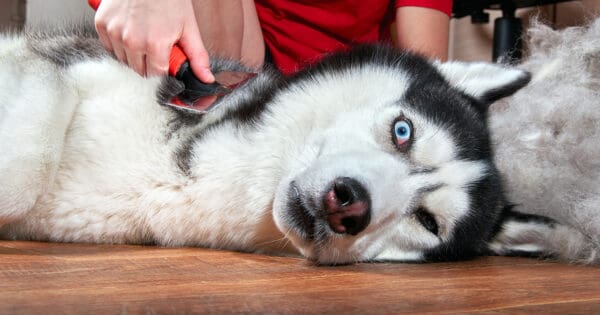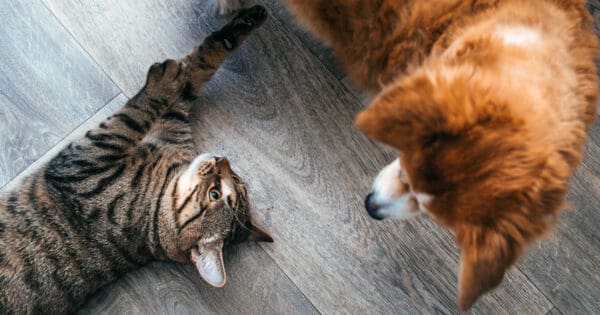Welcome to the Cascade Kennels March 2012 Newsletter
We hope everyone is enjoying the increasing daylight and that the change with Daylight Savings Time hasn’t adversely affected your pet’s feeding times.
We would first like to announce the Winner of our drawing that was held at the 2012 Seattle Kennel Club Dog Show. Congratulations Nancy Walker!!
In the March edition, we will be covering the following topics:
- Spring Cleaning the Dog-Friendly Way
- Grooming for Spring and Summer
- Pawsitive Alliance – Pawsitive Futures
- Preparedness Tips from WASART – Part 1 of 2
- Maggie’s College of Dog Training Knowledge
- March Kennel Notes
- Easy Chicken Jerky Treat Recipe
Spring Cleaning the Dog-Friendly Way
Spring cleaning can really be done any time of year if you don’t mind a blustery gust of wind blowing in through open windows in the winter or jacking up the AC so you can air the house out in the summer. Or perhaps you are lucky and live in a temperate climate so you can spring clean your home anytime you feel like it. When you have dogs, the key is to know how to spring clean your home the dog-friendly way so that everyone is safe from harsh cleaning chemicals and errant vacuum cleaners.
Your first concern is to ensure the physical safety of your dog. You can do this by parking him in a bedroom with an enticing chew toy while you clean the downstairs area and then moving him below while you do the upstairs quarters. You can also gate off an area for him in a smaller place but he will likely be pretty excitable when he sees what you’re up to. In this case, hang a shower curtain or sheet in front of the gate from the ceiling to block his view. Another option is to make a doggie playdate with a friend and her dog or, if your pet belongs to a daycare center, check out their play schedule.
Once your dog is safely away from the dusting and the vacuuming, it’s time to spring clean your home. Keep in mind that even if your pet is not at home when you clean, the residue and lingering fumes of toxic cleaners can harm him when he returns, not to mention the danger of a pet getting into those products. So, open the windows and turn on some tunes you can work to. Here are the tools you will need:
Cleaning with All-Purpose Cleaners
A good all-purpose cleaner will make your spring cleaning easier. Be careful to properly rinse all surfaces where your pet can reach and keep in mind excessive cleaning product residue could harm your pet if ingested. For those worrisome kitchen and bathroom germs, avoid cleaners with bleach or ammonia as these emit toxic fumes. Instead, use a non-toxic disinfectant or make your own solution with vinegar and rubbing alcohol.
[one_half]
Cleaning the Floors
Hardwood floors in pet households are often the hardest to clean and keep clean. Whatever cleaning solution you choose, remember that your pets may lick your floors for whatever reason and you should always make a second pass with a non-toxic cleaning solution to protect your pets. With carpeted floors, vacuum thoroughly.
Cleaning the Oven
Never use oven cleaners that work by turning on the oven and leaving it for a time. The fumes are toxic and can cause severe damage to the throat and lungs. Self-cleaning ovens are safer but take the precaution of putting a fan in the kitchen to blow any fumes out the door. If you need a pet-friendly cleaner for the oven, try a baking soda and water paste and an abrasive sponge or a non-toxic product which does not give off fumes.
Eliminating Odors
Though there are many ways to cover up odors, eliminating them is the best idea. Try leaving half-open boxes of baking soda around the house (high up and out of the reach of the dog) or a pet-friendly, non-toxic product. Never leave the odor neutralizing gels around the house even if they say they’re environmentally-friendly. If eaten, the gel could harm your pet.
After you have finished cleaning, leave the window open for another hour if possible to help get rid of any fumes. Just the smell of even a non-toxic cleaner can make your pet sneeze. Go over areas you have cleaned with a slightly damp towel to remove residue and make certain all cleaning supplies, even if they are non-toxic, are put safely away. Then, welcome your pet back into the spotless house and enjoy the short time you have before he messes it up again.
Article used with permission from Dogster.com. You may find the original article (and more) at Dogster.com
Grooming for Spring and Summer
Now is a good time to consider having your pet fully groomed for spring and summer’s warmer weather. Although we recommend more frequent grooming of your pet, many people prefer short haircuts once or twice a year. If that is your preference, now is a good time as the temperatures are mild and our normal summer rush hasn’t yet begun.
Allergies are a greater problem this time of year for both animals and humans. As your pet roams through your yard or the dog park pollen will cling to its coat. Indoor pets then shake off the pollen throughout your house. Brushing your pet before it comes back inside will help reduce pollen. Frequent grooming or, at least, frequent baths will go even further in helping reduce allergies for both you and your pet by removing the pollen from its coat.
This time of year we also tend to more frequently walk our dogs or take them to the dog park. These trips increase the chance of your dog picking up fleas from others dogs, stinky smells from those things they roll in or USOs (unidentified sticky objects) from sticking to their coat. Your groomer can help with these issues by applying specialized flea baths, cream rinses or special odor removing shampoos such as:
- Oatmeal shampoo and cream rinse for itchy skin
- Aloe conditioner for dry skin or coat
- Tea Tree Oil for dandruff and hotspots
- Plumtastic Conditioner for long lasting scent
Swimming in a lake or particularly in salt water, can contribute to mats or snarls in coats and possibly to dry skin conditions. Your groomer will have a variety of medicated shampoos or rinses that can help with dry or irritated skin. A good comb with long teeth is an excellent solution for mats or snarls in thicker coats at all times of the year since it is important to work out tangles that lie close to the skin.
As always, if you have questions or are looking for advice about grooming, please ask to talk to one of our groomers the next time you are in.
Pawsitive Alliance – Pawsitive Futures
Join Pawsitive Alliance for a fun evening out on the town to help animals in need!
When: Saturday, March 24th, 5-8 pm
Where: “415 Westlake”
Coveniently located at 415 Westlake Ave N, Seattle 98109
Ticket price includes:
- Food and beverages for the evening
- All the chocolate you can handle!
- Fabulous and fun bidding in our silent auction
- Casual yet festive attire is suggested, 21 and over
Find out more about the event as well as to get directions at the Pawsitive Alliance website!
Preparedness Tips from WASART – Part 1 of 2
Things get extra wet in the spring due to warming temperatures causing melting snow to swell rivers to capacity and beyond. Flooding can sometimes be a problem in the spring. Many of us live on a flood plain and don’t even realize it. Keep an eye out for unexpectedly high waters and remember that if you can’t see the bottom, you don’t know how deep it really is.
To begin our two part series in preparing for the unexpected, we suggest you start with a simple bag.
You’ll need a bag for each family member, including pets. A backpack will do, and it doesn’t have to be fancy. It just needs to be something to hold enough for a member of your family to get by for about 3 days. For this month, also add to your shopping list 1 gallon of water per family member, and don’t forget to count your pet in this. It’s not a lot, but it’s a start. When you get home, write the date you bought the water on the jug to make it easy to rotate out. Water can get stale.
Please be sure to check back next month for part two in this series.
This information is provided for you by the Washington State Animal Response Team. WASART is a 501(3)(c) organization that focuses on helping owners and their animals in times of disaster. More information on WASART can be found at https://wasart.org/.
Maggie’s College of Dog Training Knowledge
We would like to introduce a new feature for the Cascade Kennels web site!
Beginning today you will find a new section of the website dedicated to training tips. If you haven’t worked with her yet, Maggie Gonty is the Lead Trainer at Cascade Kennels.
Maggie’s main goal for her clients has always been for them to bond more closely to their dogs through positive, gentle, reward-based training methods that result in a well-trained dog and a well-informed dog owner.
The first tip in Maggie’s College of Dog Training Knowledge is Housebreaking a New Puppy or Dog. You can find this tip and others in the Training section or by using this link.
Grooming is offered for both overnight guests and as an independent service without overnight boarding. We also accept the feline companion and those first time puppies. Our groomers are available for brief consultations to answer your grooming questions. Find out more on our Grooming page.
Does your dog need a brush-up on obedience? We’ve added more dates and times for our training classes. You can learn more about our training offerings on the Training page and see if there are any classes that fit your schedule on the Group classes page.
Ingredients:
- Chicken Breast Fillets
Directions:
- Preheat oven to 200° F
- Lightly grease a baking sheet.
- Rinse off chicken breast and remove any fat.
- Slice the chicken with the grain. This will help make the jerky even chewier for your dog. The slices should be very thin, about 1/8″ to 1/4″ thickness.
- Place the strips on the baking sheet.
- Bake for approximately 2 hours (see note below).
- Remove from oven and cool on a wire rack until completely cool.
- Cut strips into bite sized pieces.
Storing: These homemade dog treats may not last long enough to be stored because they are so good. But, just in case they do, store them in the refrigerator for 3 weeks. Freeze any remainder for up to 8 months.
Tips & Techniques
-
- Checking – The baking times will vary due to difference in ovens, temperatures and meat size. Your jerky treats should be firm and dry, not at all soft or spongy. It is safer to go a little extra dry and firm than for the meat to be underdone.
- Cutting – Once the treats are cool, it’s easier to cut them with kitchen scissors or a pizza cutter, than a regular knife.
If you are not already, follow us on Facebook and Twitter
Cascade Kennels is the premier pet boarding solution for dogs, cats, rabbits, and exotic pets of various types. Cascade Kennels also provides outstanding pet grooming services!



